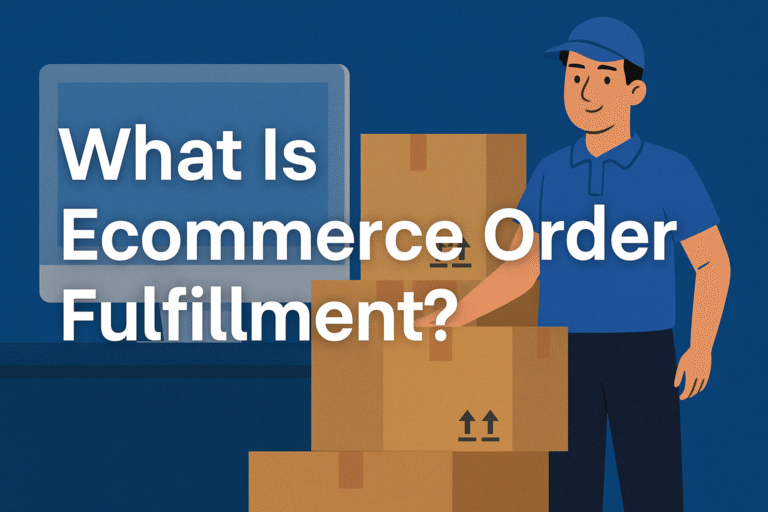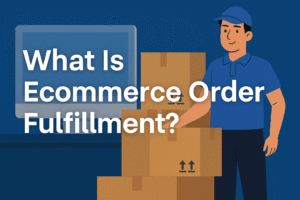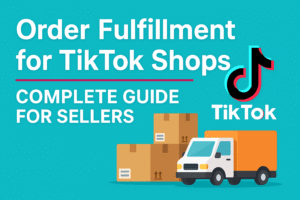Ecommerce order fulfillment is the process of receiving, storing, picking, packing, and shipping online orders to customers. It’s the backbone of every successful online store, ensuring that products move seamlessly from your digital storefront to a buyer’s doorstep. For growing brands, fulfillment isn’t just about logistics. It’s about customer satisfaction, speed, and scalability.
At its core, fulfillment determines whether shoppers come back, leave positive reviews, or abandon your brand after a poor delivery experience. That’s why many businesses turn to third-party logistics (3PL) providers like ShipBuddies, who specialize in streamlined, tech-driven fulfillment solutions that help ecommerce sellers compete with giants like Amazon while keeping costs under control.
Understanding Ecommerce Fulfillment
At its simplest, ecommerce fulfillment is everything that happens after a customer clicks “buy.” It’s the set of processes and systems that turn an online order into a delivered package. While the term often gets confused with broader “logistics,” fulfillment is more specific: it deals directly with the flow of customer orders from storage to doorstep.
Here’s the distinction:
- Logistics covers the entire supply chain, from sourcing raw materials to bulk freight distribution.
- Ecommerce order fulfillment focuses only on the final stage: receiving finished goods, storing them in fulfillment centers, picking and packing each order, arranging shipment, and managing returns.
Why does this matter? Because efficient fulfillment is directly tied to customer experience. A smooth process means faster deliveries, fewer mistakes, and higher satisfaction. Inefficient fulfillment, on the other hand, drives up costs, slows shipping, and can damage your reputation.
For growing online sellers, fulfillment is more than an operational necessity. It’s a competitive advantage. Companies that invest in streamlined order fulfillment services consistently report better reviews, higher repeat purchase rates, and stronger margins.
The Ecommerce Order Fulfillment Workflow
To understand how ecommerce fulfillment works in practice, it helps to break the process down into its core steps. While each seller’s setup can vary, the essential workflow looks like this:
1. Receiving Inventory
Products arrive from manufacturers or suppliers and are checked into a fulfillment center. Inventory is counted, inspected, and logged into warehouse management systems to ensure accuracy.
2. Storage & Inventory Management
Goods are stored in bins, shelves, or pallets until they’re ordered. Modern 3PL providers like ShipBuddies use real-time inventory systems that sync with ecommerce platforms such as Shopify, Amazon, TikTok Shop, or Etsy – preventing overselling and stockouts.
3. Picking & Packing
When an order is placed, warehouse staff (or automated systems) pick the correct items, then pack them securely. Packaging choices, including branded boxes and inserts, can reinforce brand identity while also optimizing for DIM weight to reduce shipping costs.
4. Shipping & Carrier Optimization
Fulfilled orders are labeled and handed off to carriers for last-mile delivery. Multi-carrier strategies ensure the right balance between speed and cost. This is where ShipBuddies helps businesses compete with Prime-level expectations, offering same-day and next-day shipping options where possible.
5. Returns & Reverse Logistics
A complete fulfillment workflow doesn’t end with delivery. Returns need to be processed quickly and accurately, whether that means restocking items, issuing refunds, or disposing of damaged products. Smooth returns management builds trust and encourages repeat purchases.
Fulfillment Center vs. Warehouse
One of the most common points of confusion in ecommerce is the difference between a fulfillment center and a warehouse. While both involve storing products, they serve very different purposes:
| Fulfillment Center | Warehouse |
| Designed to handle individual customer orders. | Designed for bulk storage of goods. |
| Focused on picking, packing, and shipping to end customers. | Focused on long-term storage for distributors, retailers, or manufacturers. |
| Integrated with ecommerce platforms for real-time order processing. | Minimal or no direct connection to ecommerce systems. |
| Includes returns and reverse logistics management. | Typically not set up to handle returns. |
| Optimized for speed and scalability (same-day/next-day shipping). | Optimized for cost-efficient storage over long periods. |
Why the distinction matters
- If you’re running an ecommerce store, a fulfillment center is almost always the better fit. It’s built to deliver products directly to your customers quickly and accurately.
- A warehouse may make sense for bulk B2B shipments or seasonal overflow but isn’t designed for the fast, customer-first demands of online retail.
By working with a 3PL provider like ShipBuddies, ecommerce sellers can leverage fulfillment centers that are optimized for both order speed and scalability, without the overhead of managing long-term warehousing themselves.
The Role of 3PL (Third-Party Logistics) in Fulfillment
For many growing brands, managing fulfillment in-house quickly becomes overwhelming. Storage costs, staff training, shipping errors, and system integrations can eat into margins and stall growth. That’s where third-party logistics providers (3PLs) come in.
A 3PL partner like ShipBuddies handles the entire fulfillment workflow on your behalf:
- Receiving and storing inventory.
- Syncing orders directly from your ecommerce platform.
- Picking, packing, and shipping with optimized carrier rates.
- Managing returns and reverse logistics.
Benefits of using a 3PL for ecommerce fulfillment
- Scalability: Add storage and shipping capacity as you grow, without long-term warehouse leases.
- Cost efficiency: Multi-carrier rate shopping and DIM weight optimization reduce expenses.
- Speed: Compete with Amazon-level delivery standards through same-day and next-day shipping.
- Technology integrations: Real-time API connections with platforms like Shopify, Amazon, and TikTok.
- Customer experience: Reliable fulfillment leads to better reviews, trust, and repeat sales.
Why this matters for online sellers
By outsourcing to a 3PL, ecommerce businesses can focus on product development, marketing, and scaling, while the fulfillment partner ensures operations run smoothly in the background. The right 3PL isn’t just a logistics provider; it’s a growth partner.
ShipBuddies specializes in helping ecommerce sellers streamline fulfillment so they can grow without worrying about storage limitations, shipping delays, or costly mistakes.
Platform-Specific Fulfillment (Shopify, Amazon, TikTok, Etsy)
Ecommerce fulfillment isn’t one-size-fits-all. The platform you sell on shapes the way orders are processed, shipped, and returned. Let’s look at how fulfillment works across today’s leading sales channels.
Shopify Fulfillment
Shopify integrates directly with fulfillment partners like ShipBuddies, allowing real-time order syncing, inventory visibility, and automated shipping updates. Sellers can track everything in one dashboard, reducing manual work and fulfillment errors. Branded packaging options also help Shopify merchants deliver a stronger customer experience.
Amazon Fulfillment: FBM vs. FBA vs. 3PL
Amazon sellers have three primary choices:
| Method | Description | Pros | Cons |
| FBM (Fulfilled by Merchant) | Sellers handle storage, packing, and shipping. | Full control, lower fees for low volume. | Time-intensive, limited scalability. |
| FBA (Fulfilled by Amazon) | Amazon stores and ships products. | Prime eligibility, fast shipping. | High fees, limited branding. |
| 3PL (ShipBuddies) | Independent partner handles fulfillment. | Brand control, cost flexibility, scalable tech. | Requires setup with external provider. |
For many brands, a 3PL strikes the right balance: Prime-like shipping speed without giving up branding or paying Amazon’s premium fees.
TikTok Shop Fulfillment
Social commerce is booming, and TikTok Shop is leading the way. Viral demand often creates sudden order spikes that overwhelm in-house fulfillment. A 3PL like ShipBuddies ensures sellers can handle surges, ship quickly, and maintain customer satisfaction throughout the TikTok Shop order fufillment process, even when a video drives thousands of sales overnight.
Etsy Fulfillment
Etsy sellers often start by fulfilling orders themselves, but as sales increase, the manual process can become overwhelming. Handmade products, personalized items, and custom packaging add complexity to order management. By partnering with a 3PL, Etsy shop owners can:
- Store inventory securely while maintaining product quality.
- Automate order syncing with Etsy’s platform.
- Scale during peak holiday seasons without delays.
- Offer faster, more reliable shipping to improve customer reviews.
ShipBuddies helps Etsy sellers preserve their brand identity and craftsmanship while providing the operational support needed to meet growing demand.
- Internal linking:
- Industry-Specific Fulfillment silo → Etsy, Shopify, Amazon, TikTok.
- Scaling & Costs silo → holiday/seasonal spikes.
Why Ecommerce Fulfillment Matters for Customer Experience
In ecommerce, your product isn’t the only thing customers buy. They’re also buying the experience of ordering from your brand. Fulfillment plays a huge role in shaping that experience.
Speed and Accuracy
Today’s shoppers expect fast shipping and real-time updates. Delays or mistakes in fulfillment don’t just cost you money. They cost you trust. A well-optimized fulfillment system ensures accurate orders and delivery times that match customer expectations.
Returns and Reverse Logistics
No matter how great your product is, returns are part of ecommerce. The way you handle them can make or break customer loyalty. A smooth, hassle-free returns process reassures buyers and often turns first-time customers into repeat customers.
Unboxing and Brand Perception
From packaging to inserts, fulfillment is also where your brand gets physical. A branded, well-packaged order reinforces quality, while sloppy or damaged packaging can undo all the goodwill earned through marketing.
Customer Reviews and Loyalty
Fast shipping, accurate orders, and smooth returns lead directly to better reviews, higher star ratings, and more referrals. On the flip side, fulfillment issues are among the top reasons for negative feedback on platforms like Amazon, Shopify, and Etsy.
This is why companies invest in 3PL partners like ShipBuddies: they’re not just outsourcing logistics, they’re protecting customer experience, and by extension, their brand’s reputation.
Common Ecommerce Fulfillment Challenges
Even the most experienced sellers run into fulfillment roadblocks. Understanding these challenges is the first step toward solving them, and avoiding the costly mistakes that competitors make.
DIM Weight and Packaging Costs
Carriers often charge based on dimensional (DIM) weight, not just actual weight. Oversized or inefficient packaging leads to higher shipping costs that eat into margins. Optimizing packaging design and materials helps sellers save without sacrificing protection.
You can use our DIM weight calculator to see the impact DIM weight may be having on your shipping.
Scaling During Peak Seasons
Holiday rushes, flash sales, and viral product demand can quickly overwhelm in-house fulfillment. Without additional staff or space, orders pile up and delays frustrate customers. A scalable system, or a 3PL partner like ShipBuddies, helps businesses flex capacity during demand spikes.
Multi-Channel Inventory Sync
Selling across multiple platforms (Shopify, Amazon, Etsy, TikTok Shop) creates complexity. Without a centralized system, overselling and stockouts are inevitable. Real-time inventory syncing ensures every channel reflects accurate stock levels.
Returns Management
Returns are costly and time-consuming when handled manually. Disorganized reverse logistics create frustrated customers and lost inventory value. Streamlined returns processing is essential for protecting profit margins.
Hidden Costs
From warehouse leases to labor expenses, in-house fulfillment has hidden overhead that grows as order volume increases. Many brands underestimate these costs until it’s too late.
The good news: with the right fulfillment partner, these challenges become opportunities for efficiency. ShipBuddies provides scalable storage, automated inventory syncing, optimized packaging, and multi-carrier shipping strategies, helping ecommerce businesses avoid the pitfalls and stay focused on growth.
FAQs About Ecommerce Fulfillment
To capture common search queries and address customer concerns, here are the most frequently asked questions about ecommerce order fulfillment.
What is ecommerce order fulfillment?
Ecommerce order fulfillment is the process of receiving, storing, picking, packing, and shipping online orders to customers. It ensures that products move efficiently from a seller’s inventory to the buyer’s doorstep.
How does the ecommerce fulfillment process work?
The fulfillment process includes five steps:
- Receiving inventory
- Storage and inventory management
- Picking and packing orders
- Shipping through carriers
- Returns and reverse logistics
What’s the difference between a fulfillment center and a warehouse?
A fulfillment center is designed for real-time order processing, shipping, and returns. A warehouse, on the other hand, focuses on bulk storage and long-term inventory holding. Ecommerce businesses typically need fulfillment centers for direct-to-consumer operations.
Is 3PL worth it for small businesses?
Yes. Partnering with a third-party logistics provider (3PL) like ShipBuddies helps small businesses scale without investing in warehouses, staff, and carrier contracts. It’s a cost-effective way to offer fast, reliable shipping while staying focused on growth.
How fast should ecommerce orders be shipped?
Most customers expect delivery in 2–3 days, with many preferring same-day or next-day shipping. A 3PL partner provides access to multi-carrier networks and optimized shipping strategies, helping even small brands meet Prime-level expectations.
Choosing ShipBuddies as Your Fulfillment Partner
Ecommerce order fulfillment is too important to leave to chance. Every missed delivery, delayed shipment, or packaging mistake costs more than money. It costs customer trust. That’s why many growing brands turn to ShipBuddies.
With ShipBuddies, you get more than a logistics provider. You get a growth partner. Our fulfillment network and technology are designed to help ecommerce sellers compete with giants while keeping operations simple and scalable.
Why ShipBuddies?
- Tech-Driven Fulfillment: Real-time integrations with Shopify, Amazon, Etsy, TikTok Shop, and more.
- Scalable Solutions: Flexible storage and shipping capacity that grows with your business.
- Faster Shipping: Same-day and next-day delivery options through multi-carrier optimization.
- Brand Control: Custom packaging, branded inserts, and fulfillment workflows tailored to your customer experience.
- Seamless Returns: Efficient reverse logistics that protect your reputation and keep customers happy.
Whether you’re a small business shipping your first 100 orders or an established brand scaling to thousands per day, ShipBuddies delivers the accuracy, speed, and reliability your customers expect.
Ready to simplify your ecommerce fulfillment? Request a quote today or book a demo to see how ShipBuddies can power your growth.
Meta Data
Title Tag: What Is Ecommerce Order Fulfillment? | Ecommerce Order Fulfillment Explained | Understanding How Order Fulfillment Fits Into Your Ecommerce Business | ShipBuddies 3PL
Meta Description: Learn what ecommerce order fulfillment is, how it works, and why 3PL providers like ShipBuddies help brands scale with faster, smarter shipping.







